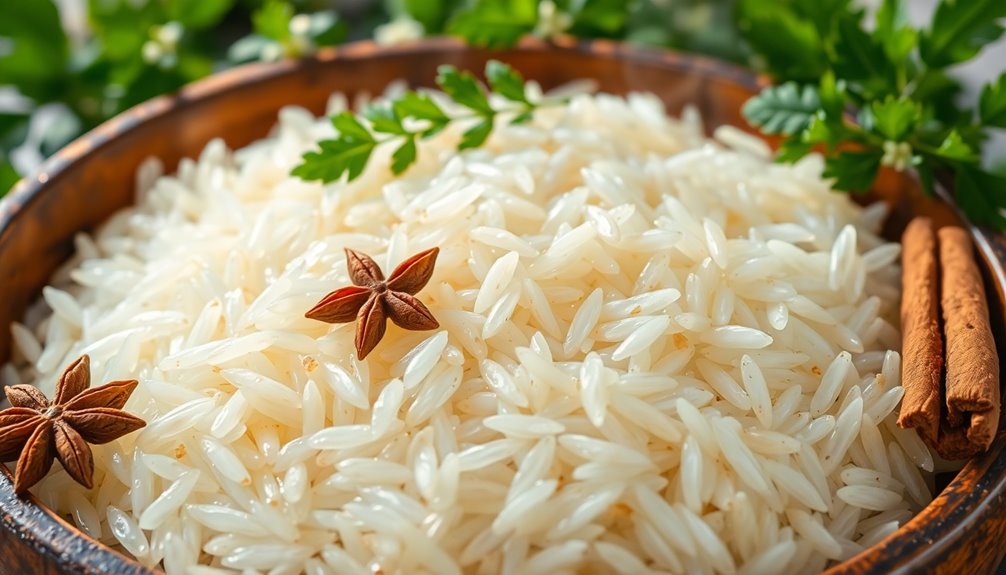Aromatic rice is a special variety known for its nutty aroma and light, fluffy texture. You'll notice its distinct flavor enhances dishes like biryanis and pilafs. This rice gets its unique scent from a compound called 2-acetyl-1-pyrroline, which is influenced by genetics. Popular types include Basmati from the Himalayas and Jasmine from Thailand, both highly sought after for their culinary qualities. Not only does this rice make your meals more flavorful, but it's also packed with nutrients. If you're curious about its many varieties and uses, there's more to explore that will satisfy your culinary interests.
Key Takeaways
- Aromatic rice is characterized by medium- to long-grained structure and a distinct nutty aroma, mainly due to the compound 2-acetyl-1-pyrroline.
- Popular varieties include Basmati from the Himalayan region and Jasmine from Thailand, both prized for their unique textures and flavors.
- The aroma of aromatic rice is linked to genetic factors, particularly mutations in the OsBADH2 gene, influencing market demand.
- This rice is ideal for traditional dishes like biryanis and pilafs, adding depth and enhancing culinary experiences.
- Growing global interest in unique flavors has increased the demand for aromatic rice, leading to higher prices and expanded production.
Characteristics of Aromatic Rice
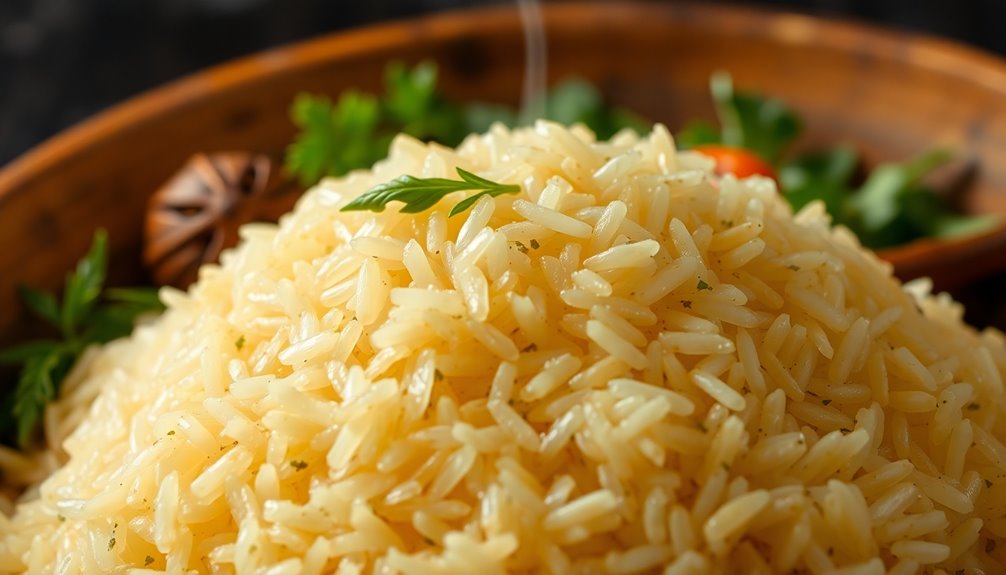
When you explore aromatic rice, you'll quickly notice its medium- to long-grained structure paired with a distinct nutty aroma and flavor. This delightful scent comes primarily from a compound called 2-acetyl-1-pyrroline, which gives each grain its unique character.
Most aromatic rice varieties have a light, fluffy texture, making them perfect for diverse culinary applications. However, Gobindobhog stands out as a stickier option, adding versatility to your meals.
The distinct aroma stems from a genetic mutation in the BADH2 gene, which can be passed through traditional breeding methods. These characteristics not only enhance the rice's appeal but also explain its significant market demand, enriching your dining experience with its exceptional flavor profile.
Popular Varieties of Aromatic Rice
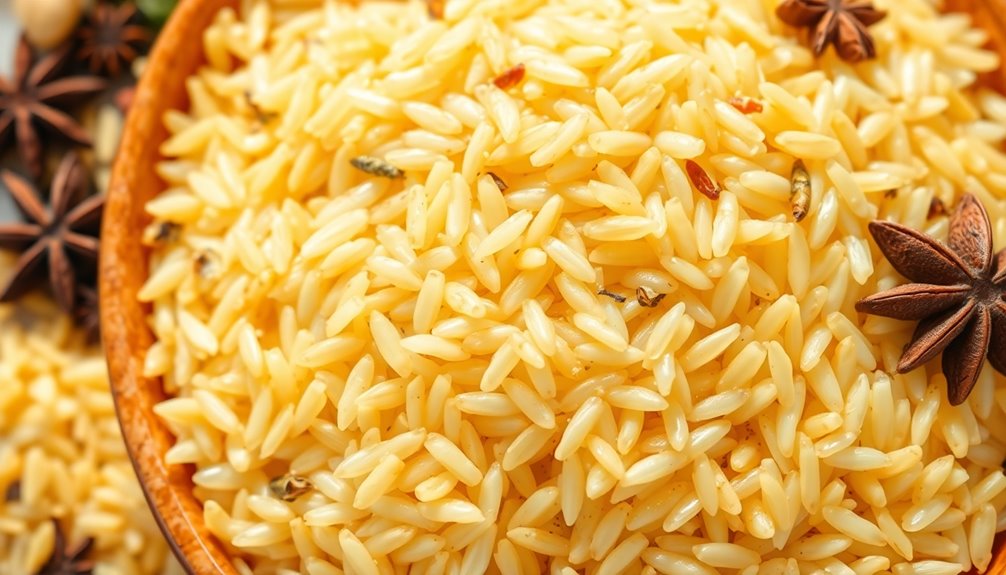
When it comes to aromatic rice, you're in for a treat with popular varieties like Basmati and Jasmine.
Each type brings its own unique flavor and fragrance to your meals, making them a staple in many cuisines.
Let's explore the distinct characteristics of these beloved rice types and some lesser-known aromatic varieties.
Basmati Rice Characteristics
Basmati rice stands out among aromatic varieties for its long, slender grains and fluffy texture, making it a favorite in South Asian cuisine.
Its unique aroma comes from the compound 2-acetyl-1-pyrroline, giving it a distinctive nutty flavor that enhances dishes like biryani and pilaf.
Grown primarily in the Himalayan region of India and Pakistan, Basmati rice is a premium fragrant rice, often commanding higher prices.
The cultivation of this rice is carefully regulated to guarantee its quality and authenticity.
- Long, slender grains
- Fluffy texture
- Distinctive nutty flavor
- Protected geographical indication
When you choose Basmati rice, you're not just selecting a grain; you're embracing a culinary tradition steeped in flavor and aroma.
Jasmine Rice Varieties
Aromatic rice varieties like Jasmine offer a delightful contrast to Basmati, showcasing their own unique qualities.
Primarily grown in Thailand, Jasmine rice is celebrated for its fragrant aroma and soft, sticky texture when cooked. This rice's delightful scent comes from a compound called 2-acetyl-1-pyrroline, giving it a distinct floral profile.
Among the various Jasmine rice types, Hom Mali stands out as the highest quality, prized for its purity and intense fragrance. Harvested once a year during Thailand's wet season, the best Jasmine rice comes from regions like Surin and Buriram.
You'll find Jasmine rice enhancing dishes such as Thai curries and fried rice, making it a staple in Southeast Asian cuisine that elevates your culinary experience.
Lesser-Known Aromatic Types
While many people are familiar with Jasmine and Basmati rice, a variety of lesser-known aromatic types can enhance your culinary repertoire.
Exploring these aromatic rice varieties can introduce you to new flavors and textures:
- Chinigura: Prized for its unique fragrance, mostly grown in Bangladesh.
- Gobindobhog: A sticky rice popular in traditional Bengali sweets.
- Tulshimala: Known for its fine quality, often featured in festive dishes in West Bengal, India.
- Kalijira: Celebrated for its delicate flavor, perfect for biryanis and pilafs.
Don't overlook Wehani, with its nutty flavor, or Texmati, a hybrid that combines the best of Basmati and American long-grain rice.
Each of these aromatic rice varieties offers a unique culinary experience worth trying!
Genetic Factors Influencing Aroma
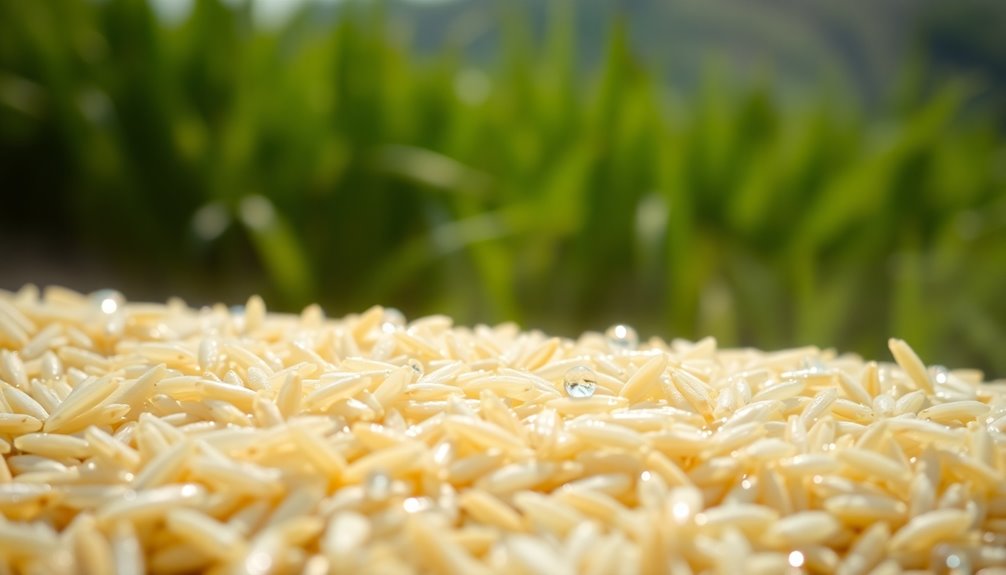
The unique aroma of rice largely hinges on genetic factors, particularly the presence of the compound 2-acetyl-1-pyrroline (2AP). This compound is produced due to mutations in the OsBADH2 gene.
Since the OsBADH2 gene mutation is recessive, both parent plants must carry this mutation for their offspring to express the aromatic trait.
Aromatic rice emerged from the genetic mixing of japonica rice with local aus rice, enhancing genetic diversity and creating distinct fragrances.
Additionally, gene editing techniques, like TALEN technology, are being used to induce specific mutations in ordinary rice varieties to boost their aromatic qualities.
Environmental stressors also play a role, influencing the expression of aroma-related genes and the biosynthesis of 2AP.
Culinary Uses and Benefits

When you choose aromatic rice for your culinary creations, you're not just opting for a flavorful ingredient; you're enhancing your dishes with its unique nutty aroma and distinct texture.
The aroma largely comes from the chemical compound 2-acetyl-1-pyrroline, which makes each bite a delightful experience. Aromatic rice varieties like Basmati and Jasmine are perfect for traditional Asian and Middle Eastern cuisines, showcasing versatility in recipes.
Consider these culinary uses and benefits:
- Ideal for biryanis and pilafs, enhancing flavor
- Adds a unique sensory profile to meals
- Nutritionally rich, offering fiber and essential vitamins
- Requires proper rinsing and cooking techniques for best results
Elevate your cooking with aromatic rice and enjoy its multifaceted benefits!
Global Market Demand

As global tastes evolve, demand for aromatic rice has surged, driven by consumers seeking unique flavors and culinary experiences.
You'll notice that varieties like Basmati and Jasmine command higher prices in both local and international markets, reflecting their premium quality.
In the U.S., imports of jasmine rice from Thailand have skyrocketed, showcasing the competitive nature of the aromatic rice market.
Recognizing this trend, U.S. farmers are seizing the opportunity to expand production of aromatic rice, aiming to reduce dependency on imports.
This segment not only enhances food security but also enriches culinary diversity, making it an essential area for ongoing research and development.
With aromatic rice's increasing popularity, the future looks promising for producers and consumers alike.
Enhancing Aroma Quality
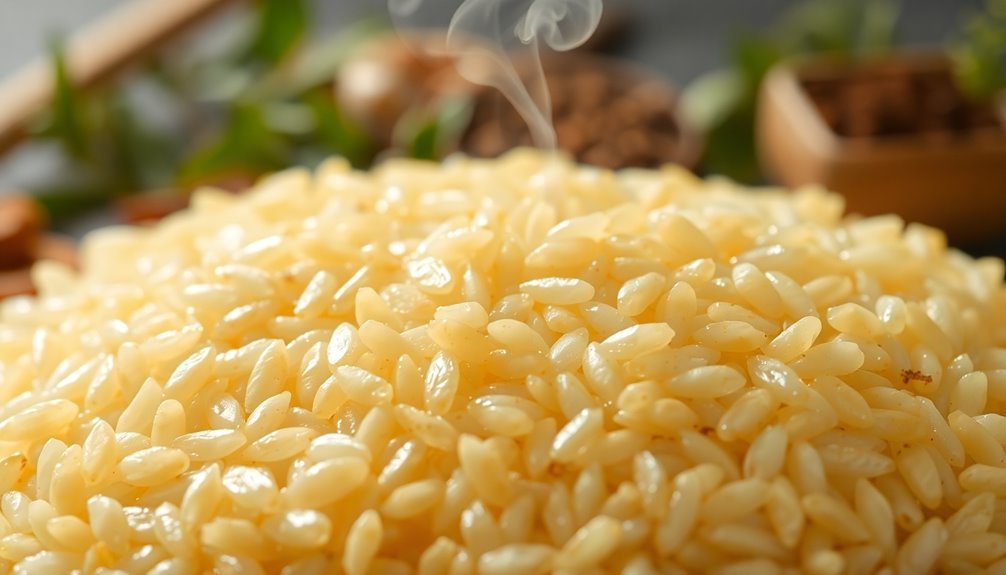
With the rising demand for aromatic rice, producers are now focusing on enhancing aroma quality to meet consumer expectations.
To achieve this, several strategies are being employed through rice research:
- Developing novel cultivars with high aroma quality
- Implementing effective agronomic practices, like proper soil management and irrigation
- Utilizing genome editing techniques, such as CRISPR and TALEN, to target aroma-related genes
- Optimizing the biosynthesis pathways of 2-acetyl-1-pyrroline
These approaches not only improve fragrance but also support sustainable agricultural practices, ensuring both quality and yield.
Frequently Asked Questions
What Is the Difference Between Aromatic and Non Aromatic Rice?
When you compare aromatic and non-aromatic rice, you'll notice distinct differences in flavor and aroma.
Aromatic rice, like Basmati and Jasmine, has a nutty fragrance that enhances your dishes. In contrast, non-aromatic rice tends to have a neutral taste, making it less appealing for certain recipes.
Additionally, aromatic rice often cooks up fluffier and more flavorful, which can elevate your meals and make them more enjoyable for you and your guests.
What Are the Examples of Aromatic Rice?
When you think about aromatic rice, you'll come across varieties like Basmati, Jasmine, and Sona Masuri, each boasting a unique flavor and fragrance.
You might also discover Ambemohar, Texmati, and Kalijira, which have distinct characteristics based on their regions of cultivation.
If you enjoy sticky rice, then Gobindobhog is a great option, especially for traditional Bengali dishes.
Each type offers a delightful experience for your taste buds!
What Is the Difference Between Basmati Rice and Aromatic Rice?
Ever wondered what sets Basmati rice apart from other aromatic varieties?
While both are fragrant, Basmati's long grains and unique nutty aroma come from specific growing regions in the Himalayas. When cooked, it fluffs up beautifully, making it perfect for dishes like biryani.
In contrast, other aromatic rice types, like Jasmine, might've shorter grains and different textures.
Is Aromatic Rice Good for You?
Yes, aromatic rice can be good for you.
You'll find it often has higher fiber content, which aids digestion and keeps you feeling full longer. Varieties like Basmati can help manage blood sugar levels, thanks to their lower glycemic index.
Plus, the unique aroma and flavor can enhance your meals, making healthy eating more enjoyable.
With potential antioxidant properties, it supports your overall health while often being grown with fewer chemicals.
Conclusion
In the world of grains, aromatic rice is like a hidden gem, waiting to elevate your meals. Its unique fragrance and flavor can transform a simple dish into a culinary masterpiece, reminiscent of fragrant fields swaying in the breeze. As you explore its varieties, you'll find not just a staple, but a story woven into every grain. So, embrace the allure of aromatic rice, and let it transport your taste buds on an unforgettable journey.

